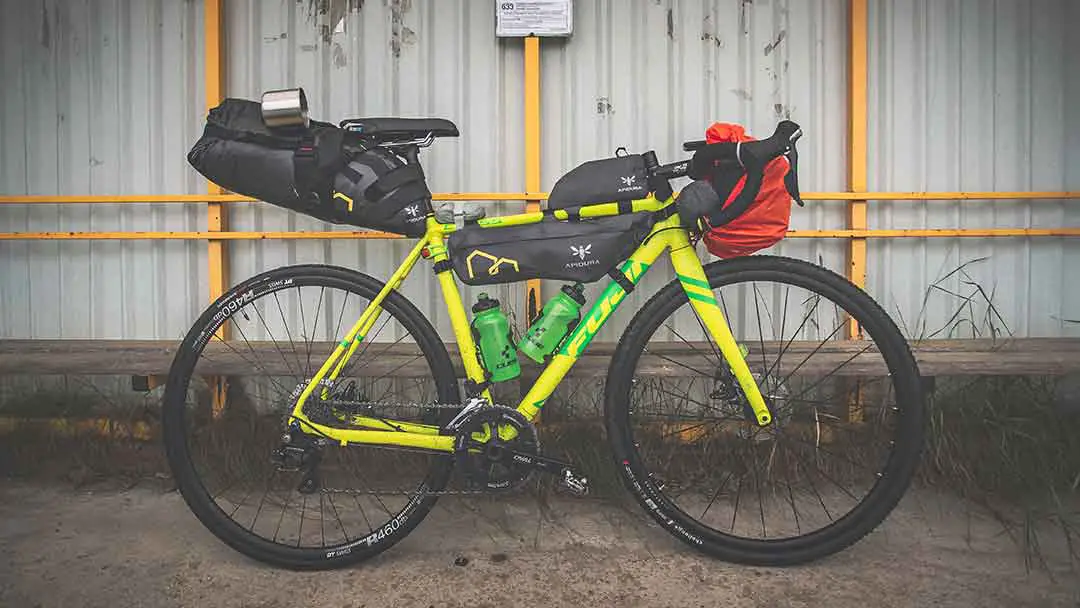Bikepacking Weight Distribution Guide

As an Amazon Associate we earn from qualifying purchases made on our website. If you make a purchase through links from this website, we may get a small share of the sale from Amazon and other similar affiliate programs. You can read our complete legal information for more details. By using this site, you agree the information contained here is for informational purposes only. For specific medical questions, consult your doctor. NO information on this site should be used to diagnose, treat, prevent or cure any disease or condition.
My mountain bike has been through a lot! From mountains in West Virginia to roughly paved roads in Colombia, it’s endured a lot of wear and tear. But keeping the weight down allows my bike to be flexible and resist breaking when I take it off-roading!
Where you put luggage and weight is almost as important as how much weight you keep on your bike. The rear of the bike and the frame are the best places to keep heavier objects. Saddle and frame bags are a great place to store your heavier luggage, such as tents, food, and extra water.
Can you hurt yourself if you bring a heavy backpack? What kind of bike is better for heavier people? Keep reading to find out!
How Much Weight Should You Carry For Bikepacking?
The amount of weight you carry varies on how you plan to travel. While some have a simple setup with little food, water, and shelter, others prefer to be more rugged.
If you choose to camp and cook outside, your setup will be heavier than eating out on your journey.
Everyone takes a different method when traveling as a bikepacker. However, there are a few prerequisites to hit for the trip to qualify as bikepacking. Generally, though, it’s a combination of touring and backpacking.
Basically, bikepacking is wilder than cycle touring. While touring takes you through towns and cities, bike touring will take you through mountain paths and wilderness.
I go into way more detail here: Bikepacking VS Touring Compared | What’s The Difference?
Some people take a completely wild excursion. They go off-roading and refuse to eat food at restaurants. This type of bikepacking experience will weigh more due to the extra food and supplies.
Alternatively, others choose to sleep in hotels or hostels while they travel. Or purchase food at take-out restaurants rather than carry their supplies with them.
While some might quibble over this being defined as bikepacking, it’s still how some people choose to take their journey.
Regardless of how you choose to travel, you’ll want to bring certain supplies.
This means that you’ll need, at minimum, to bring the following:
- Tent or hammock (check out our hammock setup guide)
- Fire starters
- Blanket and/or sleeping bag
- Cooking pot
- Voile straps (Voile straps user guide)
You’ll want a small supply of food and water for at least one day. This would translate to approximately 2-3 gallons per day per rider (if you average biking for 8-10 hours a day). As far as food goes, it’s easier to lighten the load.
Avid riders recommend you bring a day’s supply of the following easy-to-eat, easy-to-carry foods:
- Energy bars (KION bars are a great option due to their ingredients. Plus, they offer readers a 10% discount)
- Dehydrated meals (Good-to-Go is a great brand)
- Beef jerky (Carnivore Crisps offers our reader a 10% discount)
- Instant meals
While bike touring typically involves carrying more weight, bikepacking focuses more on speed and agility. Therefore, while the average touring bike is heavier and carries more weight, bikepacking has a slimmer, lighter-weight bike.
For those packing light, the average bikepacker can make do with a mere 10-12 pounds of luggage.
Mountain bikes are a great choice for bikepacking and usually weigh 25-30 pounds. If you add the bike’s weight with luggage, you can expect to carry 40-45 pounds plus your weight.
This is still much lighter than the average touring bike setup. Remember, touring is more about endurance, while bikepacking focuses on speed.
Oh yeah, we made a free downloadable packing checklist; click here.

How Do You Distribute Weight On A Bike for Bikepacking?
Most bikepackers choose to place most of the bike weight towards the center and back.
While the front is a great place to utilize extra space, avoid keeping anything that’s too heavy in this space. Too much weight up front can cause the bike to tip over or knock you off balance while you ride.
The best places to keep your heavy luggage are under the bike seat and the bike frame. You must be careful to avoid the bags touching your bike pedals and chain. This can be dangerous and cause your bike to jam while you’re riding.
Some of the best tools for carrying your supplies efficiently include:
- Backpack
- Saddle bag or backseat bag
- Front handlebar bag
- Frame bag
- Water bottle holder (this article helps: How To Install A Water Bottle Cage On A Bike Without Holes)
Unlike with bike touring, bikepacking requires everything to be as slim and light as possible. These bags and holders will help keep things tight and tidy.
Most people keep their tent or hammock in the back saddle bag. Since this is the heaviest object you’re likely to carry with you, this is the safest spot.
People tend to disagree on where to keep their food. While my backpack was always my go-to place, this might not be the best choice for everyone.
David Arthur provides an excellent breakdown of food distribution for long bike rides. However, as he points out, this is for a single-day excursion. If you feel you won’t encounter any shops or places to restock, you’ll need to carry more food.
David advises people to keep some food in the front handlebar bag. This is a good idea, especially for granola bars and quick snacks that you want to eat on the go.
However, I suggest keeping extra food, such as instant meals to cook at night, in your backpack!
Below we’ll provide a quick guide for how heavy each section of your bike should be for the best performance.
How Much Weight Should be in the Rear of the Bike?
The back portion of the bike can hold a decent amount of weight. This section typically carries the most weight since this is the section that holds our body weight.
Most bikes are designed to carry a maximum of 300 pounds in the rear, including your body weight.
Thankfully, tents and hammocks are designed to be lightweight. The average tent weighs a mere 5-7 pounds, and usually, a hammock weighs a mere 2-3 pounds. This leaves plenty of weight, but make sure you don’t overdo it.
Remember, the goal is to keep your bike as light as possible.
However, if you’re a bit heavier than the average weight, you can still participate! You might want to consider buying a specialized bike designed to hold weight exceeding 400 pounds. You might not be able to bike on extremely rugged terrain, but you’ll definitely have a blast!
How Much Weight Should be Kept on the Frame of the Bike?
Every bikepacker knows to pack their heavy items down low. This helps prevent drag and helps the bike gain speed thanks to the extra weight near the ground.
It’s a good way to use the bike’s weight to your advantage and prevent it from pulling you down.
The best way to use your bike frame is a frame bag. These bags can hold relatively heavy items, such as spare bike parts and repair tools.
These bike bags can hold an average of 5-10 pounds. Most seasoned bikers recommend you keep your repair tools and replacement tubes in this space.
How Heavy Should the Front of the Bike Be?
The handlebars should be the lightest section of your bike. Try to avoid exceeding 5 pounds in this area to avoid having your bike tip over. This space is best used for rain ponchos, a water bottle, and quick snacks.
Avoid using your handlebars to balance bags. Although it’s common for people to use their handlebars to dangle plastic shopping bags, this is dangerous. The bags can get stuck in the wheel spokes and suddenly cause your bike to stop or flip.

How Much Weight is Too Heavy for Bikepacking?
There is a lot of variability in how people choose to bikepack. Your personal weight will be the greatest contribution to the weight of the bicycle load, but it should not prevent you from adventuring.
From what I’ve found, most people keep a minimum of 15 pounds of luggage and a maximum of 45 pounds.
While anyone can bikepack, you’re likely to have a better experience if you’re within a balanced body weight. This isn’t to say you should not try to bikepack if you exceed the recommended BMI zone. But you might need to lighten your luggage load, buy a specialized bike, and cycle slower than usual.
This isn’t meant to discourage anyone from bikepacking. In fact, biking is one of the best ways to burn fat and calories. Therefore, it’s an excellent way to start balancing your weight.
It’s still a good idea to try to keep your luggage weight as low as possible. This is true regardless of your body weight, but you should be particularly cautious if you struggle with obesity.
I personally recommend keeping your load between 20-30 pounds. I always veer to the higher end since I like to keep a little extra water with me. Although, you can also rely on local supermarkets and freshwater supplies to replenish your water supply.
Just make sure you bring some water purification tablets with you or invest in a water bottle filter system.
Can a Heavy Backpack Hurt Your Back While Cycling?
Heavy backpacks can cause lower and upper back pain. This is especially true for cyclists who remain in a bent position for long periods while carrying their backpacks. Your best bet is to try to keep your backpack to less than 10 pounds of luggage.
Since most bikepacking excursions last for over a week, you’ll want to limit the weight on your body. Any excess weight will likely slow you down and cause unnecessary wear on your body.
However, I find my backpack to be indispensable for travel. There are several tricks to preventing back pain while cycling, including the following:
- Maintain a good posture
- Utilize your bike seat properly (avoid sitting on the front end, and keep your bottom on the back padding)
- Use a supportive backpack
I use a backpack with supportive back straps. Osprey makes a great pack with support.

Closing Thoughts
I hope you found this article helpful! Positioning yourself and your luggage properly is important for safe and effective bikepacking.
Proper weight distribution helps prevent wear on the tires. This means your tire will have more resistance to items that can puncture through it. So, the lighter the load, the less stress!
Finally, you should invest in proper bike gear before you head out on a journey. Polyester bags and tents are the best choices since they’re very lightweight and usually waterproof!
Sources:
REI COOP: Introduction to Bike Touring
Wikipedia: Backpacking (travel)
Backpacking Light: How Much Weight Do Bike Packers Carry (Road Trip) ?
Apidura: The Apidura Bikepacking Hydration Guide
Cyclo Scope: Bikepacking vs Touring with Panniers – All Pros & Cons
Backpacking Light: How Much Weight Do Bike Packers Carry (Road Trip)?
Bike the Site: Mountain Bike Weight: Is It Important After All?
Carry-ology: Pro Guide: How to Pack for Bikepacking Adventures
YouTube: David Arthur: How To Carry Food On Your Bike For Long Rides
Outdoor Horizon: How Much Do Backpacking Tents Weigh?
Discerning Cyclist: Do Bikes Have Weight Limits? [Best Bicycles for Heavy Riders]
Alp Kit: How to pack your bikepacking frame bag
NHS: What is the body mass index (BMI)?
Healthline: Biking for Weight Loss: 4 Effective Strategies to Try
Military in Germany: Back Pain Caused Due to Cycling and How to Reduce it
Well and Good: 7 Best Backpacks for Back Support, According to Spine Experts



